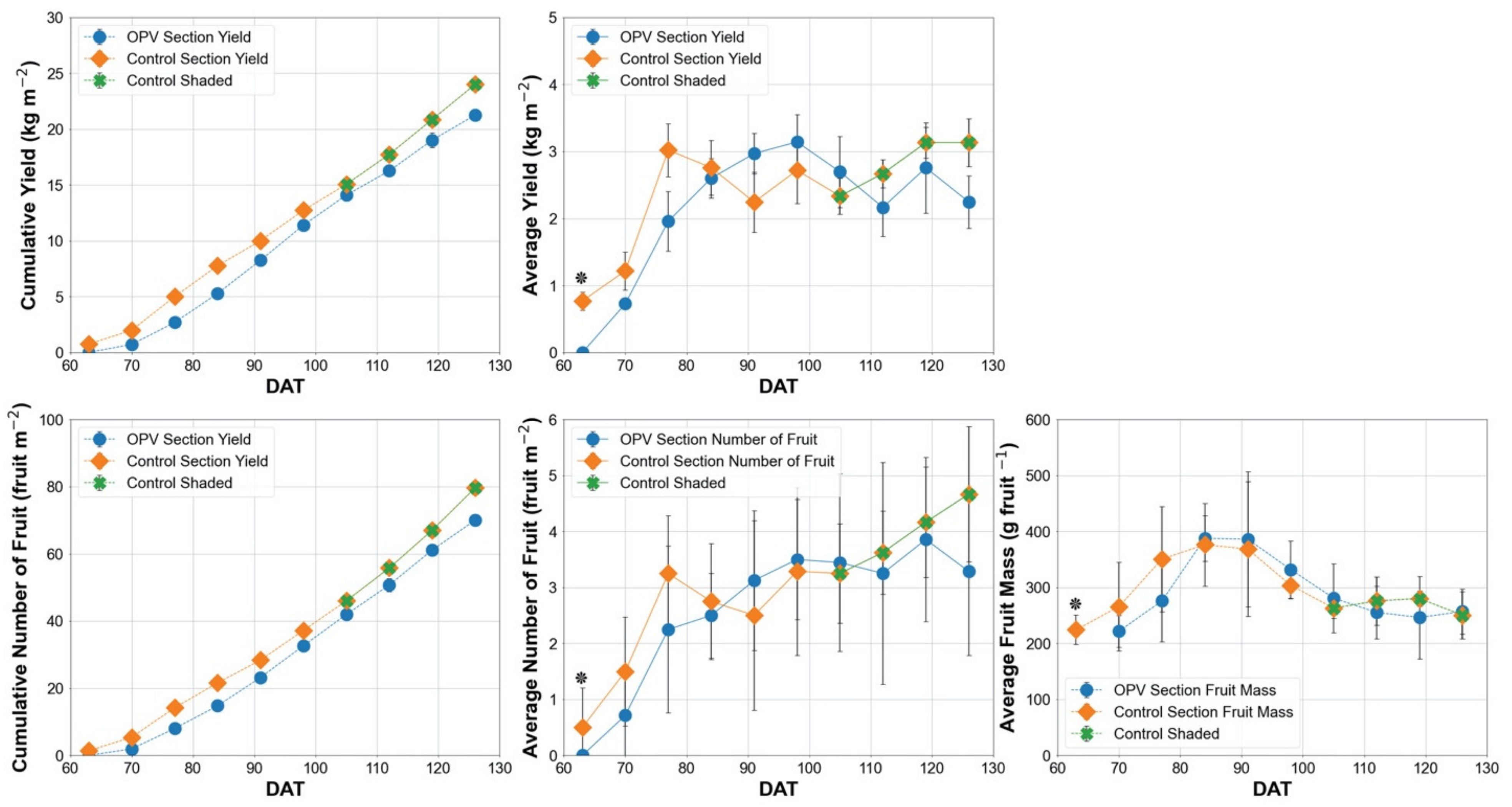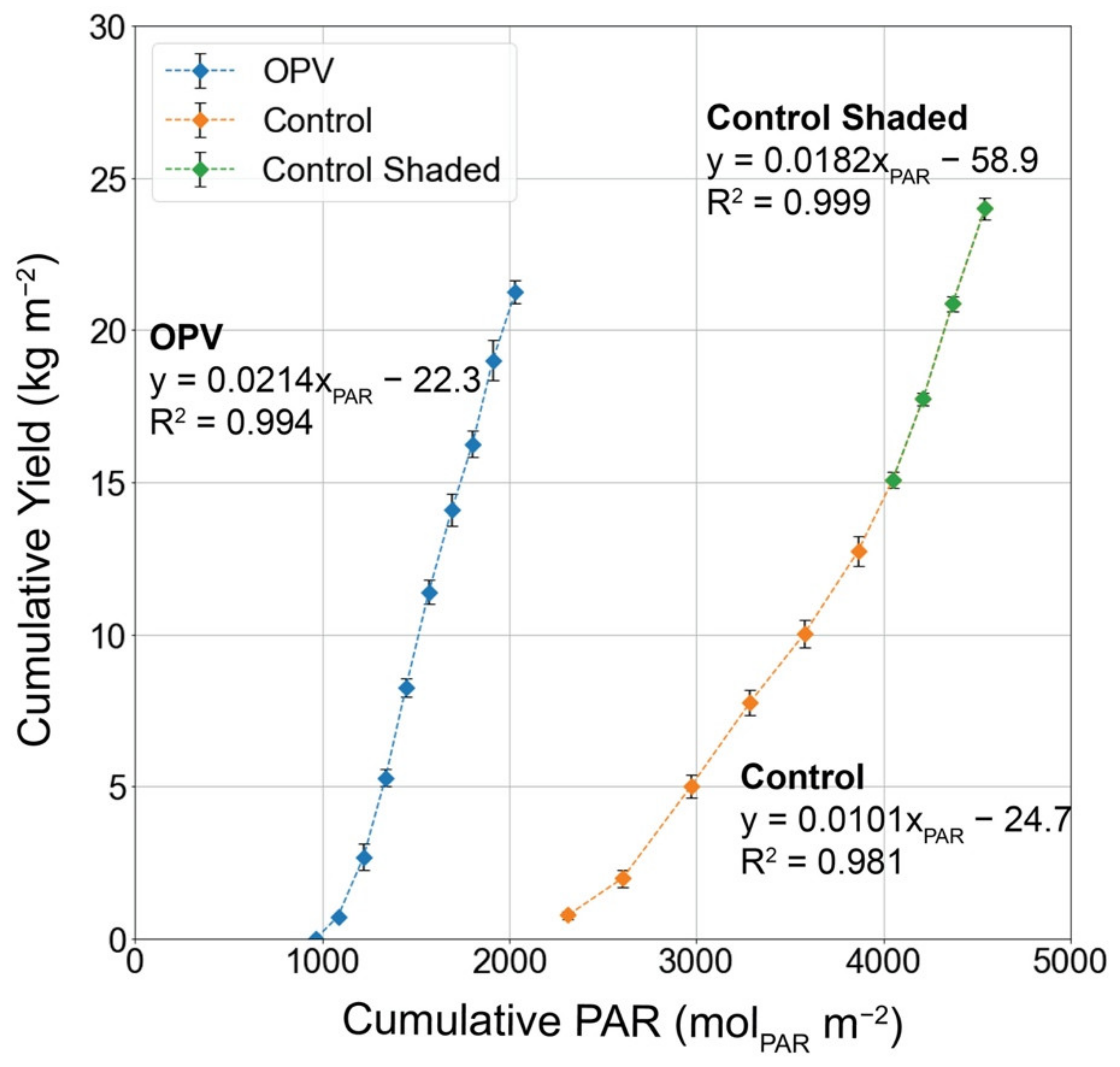1. Introduction
Greenhouse-integrated photovoltaic (PV) technologies are increasingly seen as a promising solution for sustainable greenhouse agriculture. Higher annual yields and lower water consumption compared to conventional farming make greenhouse production particularly attractive for space-limited and water-limited regions. However, the climate control systems and other electrical components involved in greenhouse operations consume large amounts of energy [
1,
2]. PV systems that are structurally integrated with the greenhouse enable the co-production of renewable energy and crops on the same land footprint, which is advantageous from a resource-use efficiency perspective [
3].
Different types of PV technologies have been tested for integration with greenhouse systems. One design strategy for PV integration with greenhouses involves the positioning of conventional opaque PVs (conv-PVs) along the greenhouse structure with gaps between them, thereby allowing a fraction of sunlight to enter the greenhouse. The challenge in this is ascertaining the correct percentage of roof coverage, balancing PV electricity generation with adequate lighting conditions inside the greenhouse [
4,
5]. In order to provide more control of the lighting conditions in the greenhouse with integrated conv-PVs, some have proposed designs with dynamically-controlled PV blind systems that can respond to outdoor conditions and sunlight variations [
6,
7,
8].
Thin-film semi-transparent or transparent PV technologies (STPV), despite showing relatively lower efficiencies compared to conv-PV, are gaining attention for their application to greenhouse structures. In contrast to conv-PV, STPV absorbs only a portion of incident light for electricity generation, leaving unabsorbed photons available for plant photosynthesis [
9,
10]. Recent advances in fabrication methods have enabled significant progress in thin-film STPV development [
11]. There are many types of technologies within this emerging class of PV (e.g., copper indium gallium selenide, cadmium telluride, amorphous silicon, perovskite, dye-sensitized solar cells (DSSCs), organic (OPV), and hybrid cells), but all share the advantages of relatively low manufacturing, transportation, and installation costs, and overall preferable life cycle characteristics compared to conv-PVs that are deposited on thick rigid substrates [
12,
13,
14]. For greenhouse applications, STPVs could potentially be deployed in larger coverage areas than would otherwise be acceptable with conv-PVs in terms of shading due to their transparency. From an electricity generation standpoint, this design advantage could compensate for relatively lower efficiency of STPVs compared to conv-PVs.
Of the STPV technologies, OPV has a number of material properties that make it uniquely promising technology for integration with greenhouses, including solution processability, spectral tuneability, and mechanical flexibility. Additionally, with regard to production, the solution processability of OPVs means that OPV device fabrication can be implemented with roll-to-roll printing technologies, thus enabling large-scale, continuous production at a fraction of the capital cost and energy input of conv-PV systems, and still lower than other STPV alternatives [
15,
16]. Environmentally, OPVs are considered preferable even to other STPV technologies, given the fact that OPVs’ material components are largely sourced from abundant earth materials and are recyclable/recoverable [
13].
The spectral properties of OPVs are important to consider for integration into any transparent or translucent surfaces (e.g., windows, screens, greenhouse covers) in order to determine the effect on transmitted light. A key figure of merit for any STPV technologies is the light utilization efficiency (LUE), equal to the product of the power conversion efficiency (PCE) and the average visible transmission (AVT), which is the weighted transmission spectrum of the STPVs against the photopic response of the human eye [
17]. For greenhouse applications, the plant response to light transmitted through the OPV material is of greater consequence than the human eye response. This issue was addressed by Emmott et al. [
18] in a modeling study of the techno-economic potential for OPV-integrated greenhouses, in which a crop growth factor (G) was used instead of AVT in an optical model that quantified the effect of various spectrally-selective OPV materials on greenhouse crops. This metric G considered the relative photosynthetic efficiency of the average crop plant at different light wavelengths, based on the work of McCree [
19]. Based on this analysis, the authors demonstrated that attaining higher efficiencies and high transparency contact materials were the most important factors in determining OPV suitability for a greenhouse, rather than the absorbance or lack thereof of the OPV material in the photosynthetically active radiation (PAR) range, which includes light wavelengths between 400 to 700 nm.
In hot regions, excessive solar radiation during the summer season requires the application of shading methods (e.g., whitewashing, external shade netting, internal shade screens, transparent spray agents reflecting NIR light, etc.) in combination with the greenhouse ventilation/cooling systems to lower cooling loads and maintain desired growth conditions for the crop. Depending on the method, solar radiation transmittance can be decreased by 30–50% compared to non-shaded greenhouses [
20]. For these locations, greenhouse-integrated OPVs could serve the dual purpose of electricity generation and shading. This potential role for greenhouse-integrated OPVs in high solar insolation regions was addressed by Okada et al. [
5], in which lettuce yield and electricity production in an OPV-integrated greenhouse system were simulated in a hot, arid climate (Arizona). It was determined that OPV roof coverage ratios of 50% and 100% during the summer could extend the growing season due to the shading provided, and 49% OPV coverage was sufficient to meet the energy demands of the off-grid greenhouse modeled in the study, with the achievement of the desired lettuce crop yields. Likewise, in an energy-balance modeling analysis of an OPV-integrated greenhouse design conducted by Ravishankar et al. [
21], assuming an OPV cell efficiency of approximately 10%, with 85% roof coverage of a glass greenhouse (219 m
2) covered by photoactive OPV area, it was shown that the OPV system was able to produce more than enough electricity to cover the energy requirements of a greenhouse tomato production system in an arid climate such as Arizona. Building on this work, Hollingsworth et al. [
22] examined the life-cycle environmental and economic impacts of OPV-integrated greenhouses compared to non-PV-powered and conventional-PV-powered greenhouses and concluded that OPV-integrated greenhouses could outperform the alternatives if there were not significant reductions in crop yields due to OPV-related shading effects.
Evidently, the potential scope of the use of OPVs for greenhouse applications is in large part dependent on understanding the effects of the OPV light modification on the greenhouse microclimate and crop. The response of greenhouse crops to the lighting conditions resulting from the integration of STPV technologies with the greenhouse structure is an increasingly researched topic [
23]. A number of these studies have experimented with tomato plants, a major greenhouse vegetable crop worldwide, which is often shaded in high-light regions to mitigate heat stress and fruit quality issues caused by high radiation intensities and air temperatures [
24].
Li et al. [
25] evaluated resource use efficiency, greenhouse microclimate, and crop yields in a greenhouse covered with glass laminated with luminescent solar concentrator-based PV cells. The PV system evaluated exceeded the energy demands of the 103 m
2 research greenhouse facility located in Tucson, Arizona, equipped with wet-pad and fan cooling system and a natural-gas-based heating system, growing cherry tomatoes with 25.3% more light use efficiency (LUE) in the PV-covered greenhouse compared to the control greenhouse that was covered with double-layer acrylic.
Hassanien et al. [
10] investigated the effect of shading by mono-crystalline silicon semi-transparent panels mounted on top of a polycarbonate-covered greenhouse, occupying 20% of the roof area, on the growth of container tomatoes. It was determined that there were no significant differences in the growth of the tomato plants in the PV-integrated greenhouse compared to the unshaded greenhouse.
Ntinas et al. [
26] tested a hydroponic tomato cultivation system for medium-sized and cherry varieties in two glass greenhouses, with one greenhouse outfitted with a DSSC cover and the other greenhouse serving as a control. A variety of plant physiological and productivity parameters were measured to determine the effects of the filtered lighting resulting from the integrated DSSC cover. Illuminance was reduced by 20% in the DSSC greenhouse compared to the control. Although the results showed that plants grown in the DSSC greenhouse were found to have relatively lower yields overall, it was found that the shading in the DSSC greenhouse during the summer season was beneficial for the qualitative characteristics of the tomato fruits.
Friman-Peretz et al. [
27] compared the microclimate and tomato crop response between a polytunnel with OPVs installed on the roof, contributing 23% shading to the growing space, and a control greenhouse over two seasons in 2018 and 2019 in a Mediterranean climate. Air temperature and humidity levels inside the OPV greenhouse were found not to be significantly different compared to the control. Radiation distribution inside the OPV greenhouse was less homogenous than the control due to the gaps between the OPV strips deployed on the greenhouse roof. The cumulative yield and average fruit mass were higher in the OPV greenhouse in 2018 and not significantly different in 2019 when a 25% shade cloth was installed on the control greenhouse.
Until now, greenhouse studies evaluating the effects of integrated STPVs, including OPVs, on the tomato crop response and microclimate have experimented with limited/partial shading treatments (less than 25%). As mentioned previously, for greenhouses located in hot and sunny regions, higher shading may be required/desired during the spring and summer production seasons. In order to determine the feasibility of using semi-transparent OPVs as a realistic alternative for conventional greenhouse shading methods, it is critical to test higher shading treatments, which are more representative of typical cultural practices in such regions. Higher shading treatment also involves larger areal coverage by the OPV materials on/in greenhouses—the relatively low efficiency of OPVs compared to silicon PVs necessitates a larger coverage areas, which for this design application would also be desired in order to achieve high shading treatments. The present study addresses the lack of large-scale experimental research into the application of OPVs as a seasonal greenhouse shading method for hot and arid regions. Flexible, semi-transparent, roll-to-roll printed OPV arrays were installed as a roof shade cover on a greenhouse hydroponic tomato production system in a dry, desert region (southern Arizona) characterized by high air temperatures and radiation intensities in the spring and summer. Analyzing the effects of a relatively high OPV shading treatment on the greenhouse microclimate and tomato crop growth and yield, this study provides insights and recommendations for the design and application of greenhouse-integrated OPV shading elements.
2. Materials and Methods
2.1. Study Greenhouse
The study greenhouse was located at the University of Arizona Controlled Environment Agriculture Center in Tucson, Arizona (latitude: 32°16′ N, longitude: 110°56′ W, altitude: 728 m).
Figure 1 shows a 3-D schematic of the greenhouse structure, which was developed in a Rhinoceros CAD environment (Robert McNeel & Associates, Seattle, WA, USA) [
28]. The greenhouse had a 9.1 m × 14.6 m footprint with 1.8 m sidewalls and a height of 4.9 m at the roof apex, a gothic-arch roof profile, and a true north-south orientation (Golden Pacific Structures, Cincinnati, OH, USA). The greenhouse cover material was double-layer, air-inflated 8-mm low-density polyethylene (LDPE) plastic with a light transmittance of approximately 75% for all solar radiation wavelengths and 65% in the PAR range. The greenhouse climate control system (EnviroStep, Wadsworth, Arvada, CO, USA) controlled air temperature via evaporative cooling with a wet-pad and two exhaust fans positioned on the northern and southern walls, respectively. Two horizontal airflow (HAF) fans located close to the roof in the northwest and southwest quadrants were continuously operating (day and night) to facilitate air distribution throughout the growing space. External environmental conditions were monitored at a climate station positioned at the northern apex of the greenhouse roof, measuring ambient relative humidity and air temperature (HMP60, Vaisala, Helsinki, FI, USA) and horizontal shortwave irradiance with a pyranometer (SP-510, Apogee Instruments, Logan, UT, USA).
2.2. OPV Device Characterization and Installation on Greenhouse Roof
The OPV devices used in this study were PBTZT-stat-BDTT-8 based full solution coated, flexible, semi-transparent organic photovoltaic cells (manufactured by ARMOR Solar Films GmbH, formerly known as OPVIUS GmbH, Kitzingen, Germany). Each 800 mm × 1000 mm OPV panel was comprised of 4 serially-connected OPV modules, with each module containing of ten 12.5-mm-by-660-mm serially-connected cells, with 2.5-mm gaps (‘dead area’) between the cells; the active area (i.e., areas covered by the cells) constituted 75.8% of each panel. Eight OPV panels were laminated together and wired in parallel to form an OPV array that measured 6400 mm ×1000 mm × 0.6 mm and weighed approximately 6 kg, with a total active area of 3.4 m2 per array. The OPV arrays had been deployed in a different design configuration on the greenhouse roof since October 2019 for a previous study characterizing the OPV array electrical performance; 6 OPV arrays were producing power at the time of measurement for the present study.
The OPV arrays were positioned on the northern section of the greenhouse in a contiguous pattern to fully cover both the east and west greenhouse roof pitches and partially cover the sidewalls (
Figure 1). Nylon cord was used to connect the corners of the opposite-facing OPV arrays at the greenhouse roof apex. The opposite end of each array was tied to the greenhouse base near the ground. Additionally, heavy-duty LDPE adhesive tape (GGR Supplies, Miami, FL, USA) was used to adhere the OPV arrays to the polyethylene cover. The OPV shade cover initially comprised eight OPV rolls. Two additional OPV arrays were installed on 11 June 2020 on the northern edge of the OPV shade cover to increase the shaded area, as the solar elevation angle had increased over the course of the study period (see
Section 2.2). The total OPV area installed on the greenhouse roof was 51.2 m
2 initially, and then 64 m
2 with the two additional OPV rolls. Thus, the percentage of the OPV shade cover active area was 38.8% initially and then 48.5% with the additional two OPV arrays installed.
Electrical monitoring of the OPV arrays was conducted using an automated current-voltage (I-V) curve measurement system, which was programmed in the Python language. The system operated via serial communication protocol between a laptop (HP, Palo Alto, CA, USA) and a DC programmable electronic load device (8542B, B&K Precision Corporation, Yorba Linda, CA, USA). The OPV arrays were connected to the electronic load, and I-V curves of the OPV arrays were then taken in 10-min intervals during daylight hours (5:00–20:00 h), with the OPV array held at open-circuit between I-V curve measurements. The electronic load device used was capable of monitoring one OPV array at a time, and thus each OPV array was connected to the I-V curve measurement system for a one day of data collection and then subsequently disconnected.
2.3. Shading Effect of the OPV Arrays
Due to the changing solar zenith over the course of the study period, the position of the shading on the greenhouse floor resulting from the OPV shade cover shifted.
Figure 2 illustrates the shifting position of the shadows caused by the overhead OPV shade cover on the greenhouse floor during the measurement period; the shadow positions were simulated using the Sun analysis feature in the Rhinoceros CAD program [
28], which takes location, date, and time as inputs to calculate the solar angle, and then represents the sun at the calculated angle as a strong directional light cast on the 3-D geometry. The OPV planting area was positioned such that the central sampling region (see
Figure 3) would be continuously shadowed by the OPV coverage for the duration of the measurement period. The northern section of the growing area that was shaded by the OPV is hereafter referred to as the ‘OPV section’. The non-OPV shaded section is hereafter referred to as the ‘Control section’. The Control section was initially unshaded for 98 days of the study, from 11 March 2020 to 10 June 2020, and then a 30% shade net was installed on the greenhouse roof where the control plants were located on 11 June 2020, enabling a comparison between the OPV shade cover and conventional shading method. The shade net resulted in a relatively proportional decrease in the transmittance of all solar radiation wavelengths in the Control section; its spectral properties are explained further in
Section 3.3. The period in which the Control section was unshaded and the period in which the shade net was deployed are distinguished in the reported results.
2.4. Growing System and Microclimate Monitoring
Figure 3 shows a schematic view of the greenhouse growing area layout and positions of the environmental sensors. One hundred and eight grafted tomato seedlings (‘Rebelsky’ variety) were transplanted into the growing system on 5 March 2020, and crop data collection began on 11 March 2020. The tomato plants were planted in stonewool cubes fixed to stonewool slabs (GRODAN, Roermond, The Netherlands) in double rows along three gutters with a length of 9.7 m and a gradient of approximately 1%. The distance between the middle of the gutters was 1.8 m. An approximate 1.8-m gap separated the southernmost OPV-shaded plants and the northernmost control plants, with a planting area of 3.7 m × 5.4 m (17.3 m
2) for both the OPV and Control sections (see
Figure 2). Each section contained 54 tomato plants, with 9 plants in each of the six rows, resulting in a planting density of 2.70 plants m
−2 in each section. The growing system was designed and operated as a fully automated recirculating hydroponic system. The OPV and Control sections received the same irrigation schedule and nutrient solution (Hoagland’s solution), with EC and pH levels controlled with an automated dosing unit (Intellidose, Autogrow, Auckland, NZ, New Zealand). For the measurement of plant transpiration, lysimeters were positioned to capture irrigation input and drainage from six plants located in the center of each section. The volume, electrical conductivity (EC), and pH of both irrigation input and drainage were measured each morning at around the same time with a handheld EC/pH meter (HI-9814, Hanna Instruments, Smithfield, RI, USA).
All sensor positions in the growing area are shown in
Figure 3. Global shortwave irradiance was measured at the canopy-level using 6 shortwave pyranometers (SP-510, Apogee Instruments, Logan, UT, USA) positioned in the east, center, and west planting areas in both the OPV and Control sections. All solar radiation measurements reported for the OPV and Control sections are averaged values from the east, center, and west pyranometers in the two sections. One air temperature/humidity sensor (HMP60, Vaisala, Helsinki, FI, USA) was located centrally at the canopy-level in each section. Canopy temperature was continuously monitored from 14 May 2020 onward using two infrared radiometer sensors (SI-111-SS, Apogee Instruments, Logan, UT, USA) positioned in the center of the OPV and Control sections (
Figure 3).
The measurement period for the crop spanned 126 days (18 weeks), concluding on 11 July 2020. Crop data were collected weekly for 12 randomly tagged sample plants—6 plants per section, located in the inner four rows close to the center of each section (
Figure 3). The growth parameters measured both vegetative and reproductive behavior in the crop, specifically head growth (i.e., terminal growth), stem diameter, leaf length, distance of flower growth to the bottom of the apical meristem (i.e., ‘tip’), number of fruiting trusses, and the number of open and closed flowers. Yield data were also collected weekly beginning 62 days after transplant (DAT) once fruit had begun to ripen. Yield parameters included total fruit mass, the number of fruits, and average fruit mass. The independent two-sample Student
t-test with a
p-value of 0.05 was used to determine statistical significance in the growth and yield parameters measured between the OPV and Control sections.
Lighting quality was measured using a portable spectroradiometer (PS-300, Apogee Instruments, Logan, UT, USA) both outside the greenhouse and in the same positions as the pyranometers on two clear-sky days (20 and 22 May 2020) in the morning, midday, and afternoon, with additional measurements taken of the Control section once the shade net was installed. The spectroradiometer measurements indicate the intensity of shortwave radiation wavelengths between 300–1000 nm incident on the plant canopy in both the OPV and Control sections. Estimates of PAR, typically represented in μmol m−2 s−1, incident on the crop canopy in the OPV and Control sections were calculated. These estimates were based on simultaneous measurements taken with a handheld full-spectrum quantum meter (MQ-501, Apogee Instruments, Logan, UT, USA) and a handheld shortwave pyranometer (MP-200, Apogee Instruments, Logan, UT, USA) taken in multiple locations under the OPV shade and under the polyethylene in the Control section. A generalized ratio for PAR to shortwave radiation was determined: in the OPV section, the ratio was 1.81 μmol m−2 s−1 of PAR for every 1 W m−2 of shortwave radiation; in the Control section, the ratio was 2.11 μmol m−2 s−1 of PAR for every 1 W m−2 of shortwave radiation. These ratios were applied to the continuous canopy-level shortwave radiation measurements to estimate canopy-level PAR, which is presented in the analysis as weekly average values. All continuously monitored conditions inside and outside the greenhouse were sampled every 15 s and averaged every 10 min, with average values recorded on two dataloggers (CR-3000 and CR-1000, Campbell Scientific, Logan, UT, USA).
4. Conclusions
This study demonstrated the application of commercially manufactured, semi-transparent, flexible, roll-to-roll printed organic photovoltaic (OPV) arrays (3.4 m2 active area) as a shade element for greenhouse tomato production in a hot, arid climate. The OPV arrays decreased the transmittance of all solar radiation wavelengths in the shaded area by approximately 40% and photosynthetically active radiation (PAR, 400–700 nm) by approximately 37%.
During the hottest months of the measurement period (May–July), the OPV shade provided a suitable climate for tomato crop production, stabilizing canopy temperature during the times of day with the highest solar radiation intensities, performing the function of a conventional shading method. Constrained solar radiation levels in the OPV section for three weeks following transplant in early March, in which the daily light integral (DLI) values were estimated to be lower than the recommended minimum of 15 molPAR m−2 day−1, resulted in more vegetative growth and delayed fruit development and ripening compared to the Control section, indicating shade avoidance behavior, and leading to lower average yields in the first three (of 10 total) weekly harvests. Beginning with the fourth harvest, however, yield, fruit number, and fruit mass in the OPV and Control sections were similar. Trends in yield productivity for the OPV plants showed increased performance during high-light-intensity periods in May and June. The light utilization efficiency (LUE), which is the relationship between cumulative yield and cumulative PAR radiation, measured in g molPAR−1, was approximately twice as high in the OPV section (21.4 g molPAR−1) compared to the Control section when it was unshaded (10.1 g molPAR−1); during the period in which the Control section was shaded, the LUE increased to 18.2 g molPAR−1.
Although the electrical performance of the OPV arrays used for this study varied, the east-west orientation and extensive coverage of the OPVs over the curved greenhouse roof meant that power production could be relatively evenly distributed throughout the day. It can be concluded that the daily electrical energy requirements for the greenhouse in this study with its installed hardware during the summer production season in this region could be met with full roof coverage by OPVs and with efficiencies between 1.1–2.1%, which is in the performance range of the devices used in this study.
Future investigations of OPV applications to greenhouses should test crop types with different light requirements, seasonal effects, effects of OPVs on plant water and nutrient efficiencies, OPVs with different spectral characteristics (higher light transmittance in the PAR spectrum), the effects of degradation on OPVs’ spectral characteristics over time, and different OPV installation strategies. The dynamics of energy production/consumption in integrated OPV greenhouse systems should also be explored in future work.
Ultimately, this study demonstrated a readily available design strategy for OPV applications to greenhouses in high-light regions, where shading methods are required for spring and summer greenhouse crop production.


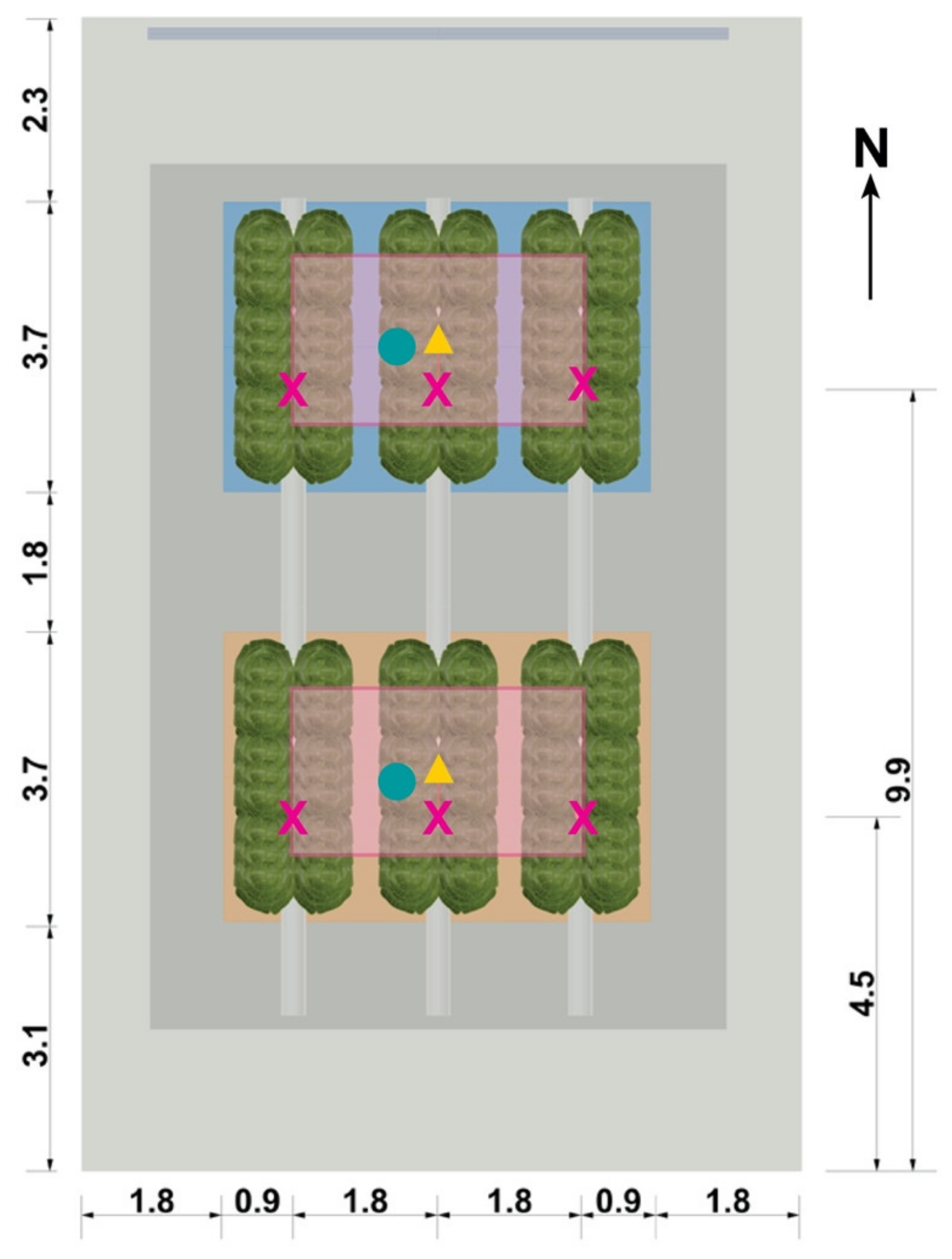
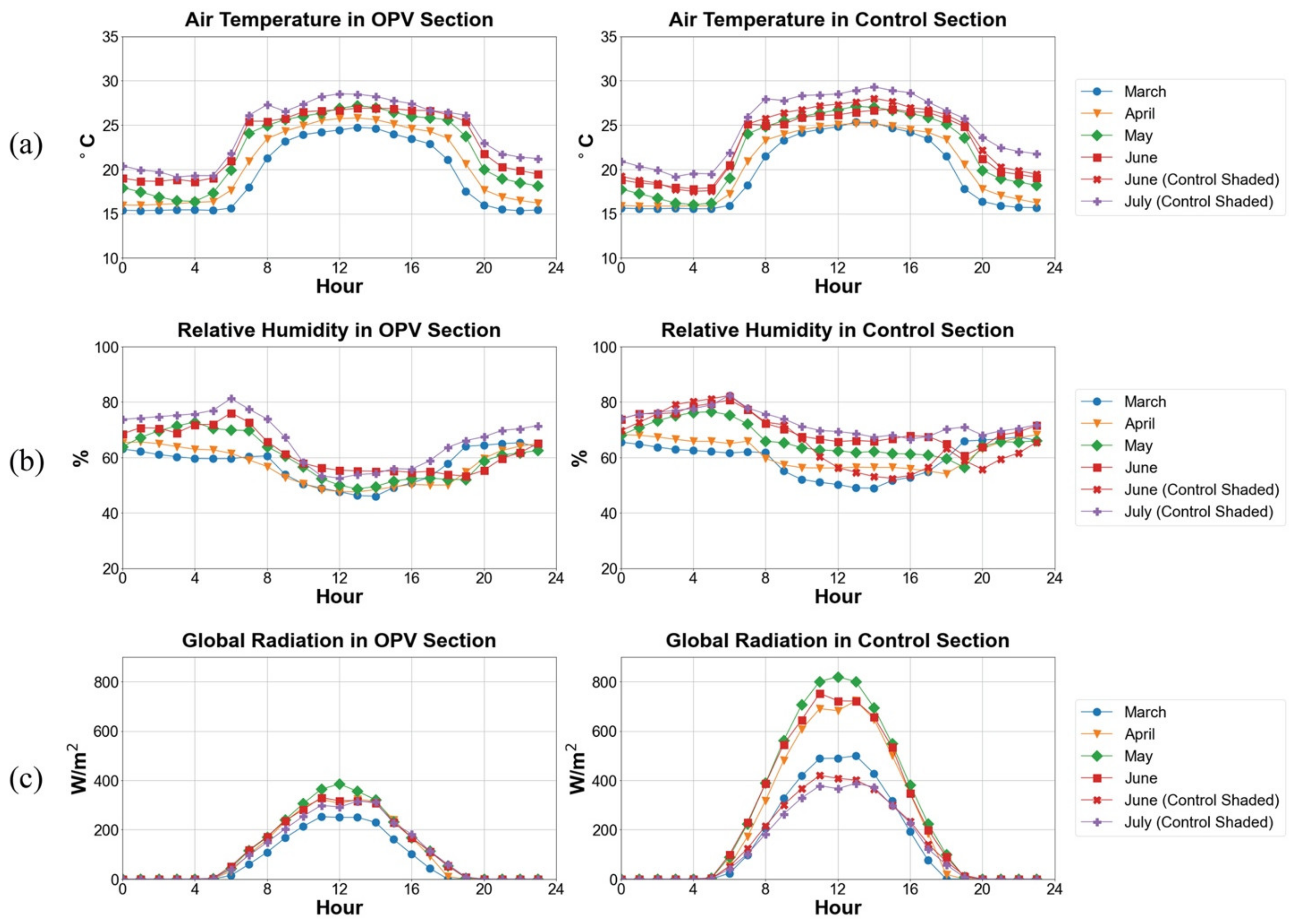

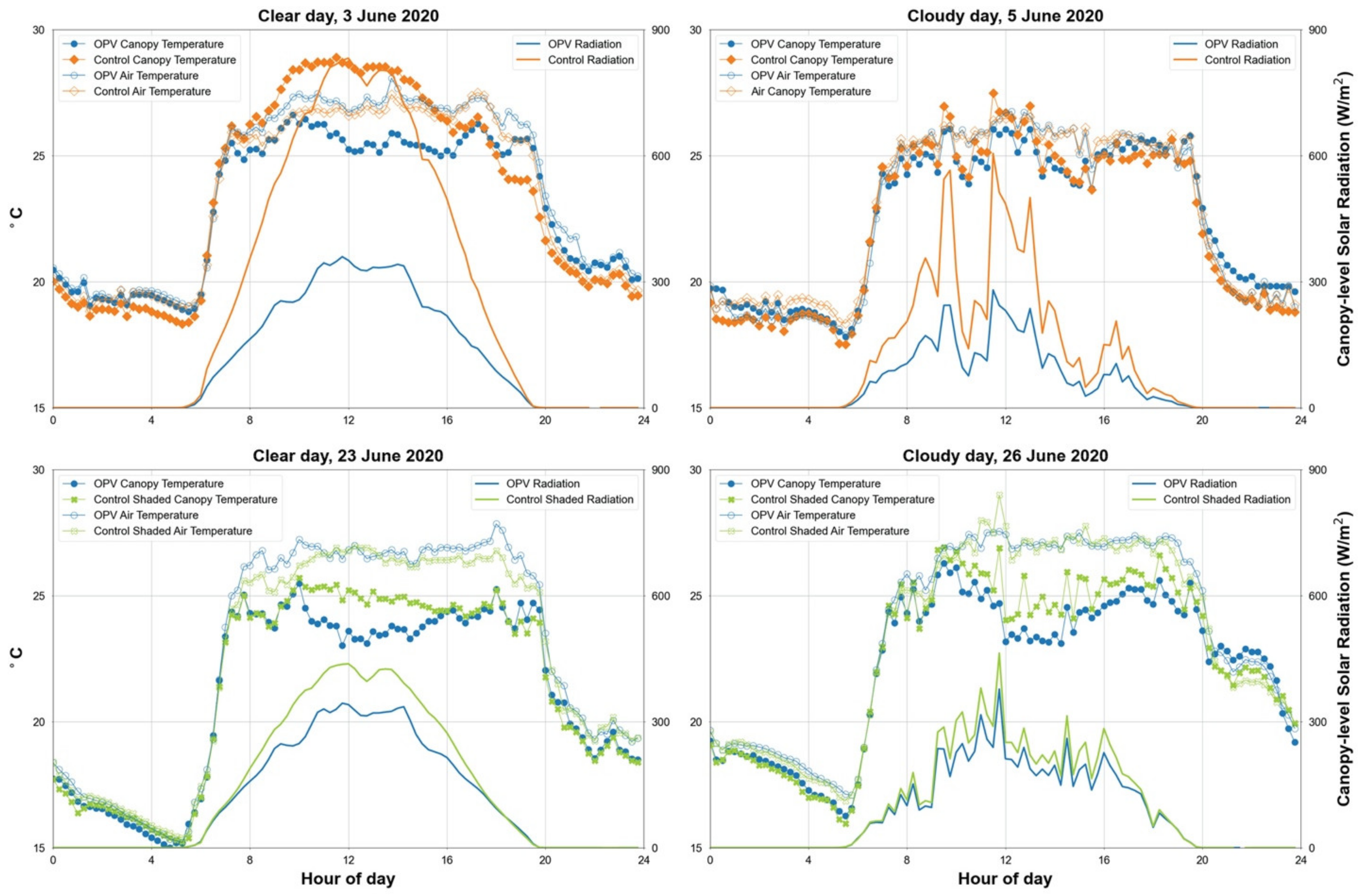


 indicates a significant difference based on a two-sample t-test statistic, calculated for the OPV and Control sections.
indicates a significant difference based on a two-sample t-test statistic, calculated for the OPV and Control sections.
 indicates a significant difference based on a two-sample t-test statistic, calculated for the OPV and Control sections.
indicates a significant difference based on a two-sample t-test statistic, calculated for the OPV and Control sections.
 indicates a significant difference between the samples for that week of measurement.
indicates a significant difference between the samples for that week of measurement.
 indicates a significant difference between the samples for that week of measurement.
indicates a significant difference between the samples for that week of measurement.